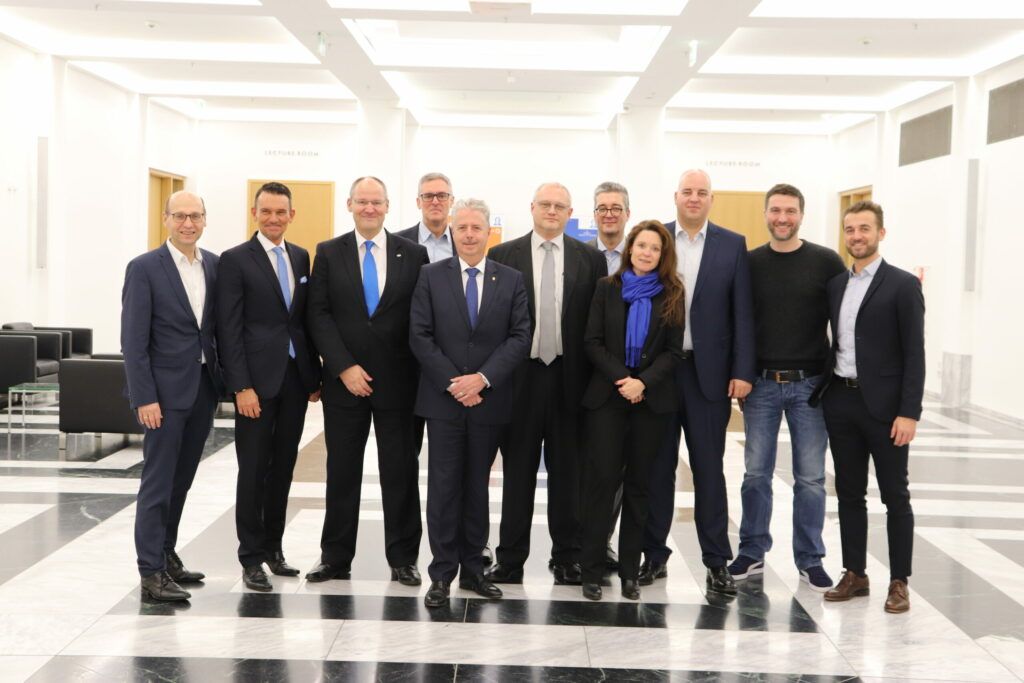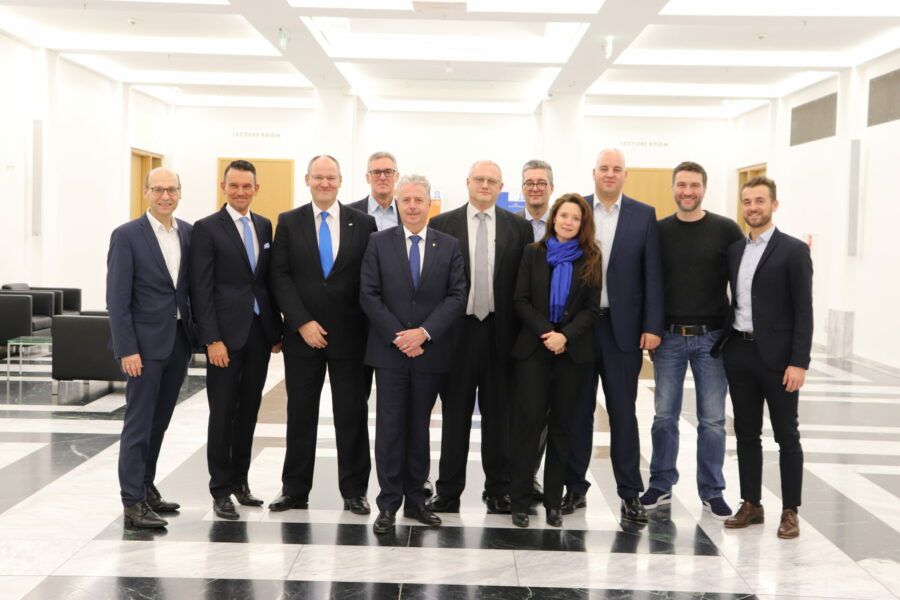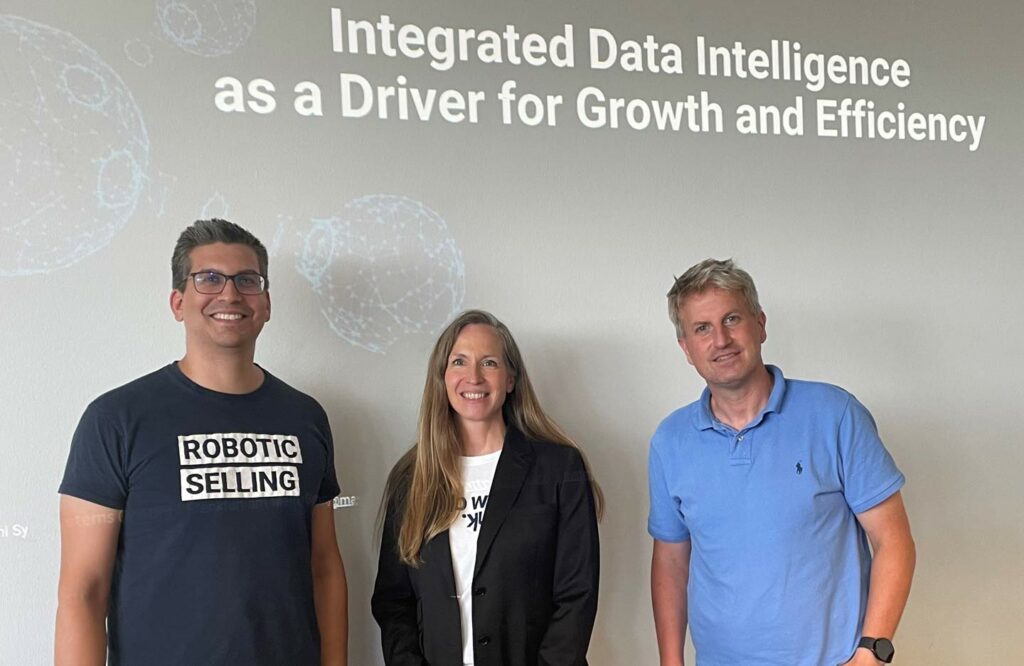Part 2: Our Head of Sales & Business Development, Anton Lengle, presents how predictive analytics works together with an enterprise data platform to participants from various industries at the House of Finance at Goethe University.
In the future, marketing and sales in the insurance industry will need more integration of their systems, overarching processes and intelligent automation. In other words, the future belongs to Robotic Selling – and our technological solutions for it. At the Robotic Selling event, which took place on Nov. 18, 2019, at the House of Finance on the Westend Campus of Goethe University, Frankfurt, the speakers and the approximately 80 professionals from the insurance industry were practically in agreement on this. Invited to the House of Finance were The Federal Association of Sales Managers e.V. (BdVM) , the Federal Association of Insurance Managers e.V. (VGA), the Association of Insurance Business Managers (VVB) and the Chair of Electronic Commerce of the Goethe University Frankfurt am Main itself – more precisely: Prof. Dr. Bernd Skiera , the holder of the Chair of Electronic Commerce and co-founder of Marini Systems. Bernd Skiera was also the first speaker that evening, followed by Anton Lengle, our Head of Sales & Business Development. The third presentation was held by one of our customers. Lars Georg Volkmann, Sales Director of VPV Lebensversicherungs-AG, reported on the success of robotic selling in practice.
System diversity at companies opens up opportunities for integration and synchronization
In his presentation at the Robotic Selling Event at Goethe University, Anton Lengle, our Head of Sales & Business Development, outlined the opportunities that integration and automation open up for robotic selling – and the role that approaches such as iPaaS and external services play in this. His starting point: companies today are using more and more software systems. In large companies with 1,000 employees or more, there are often more than 200 systems, but even in smaller companies with up to 50 employees, an average of 40 systems are already in use – and the trend is rising. However, the greater the number of different applications and users, the greater the complexity that these systems create in the company. This results in five important problems for companies:
- Redundancy: Data is maintained twice far too often.
- Inconsistency: Data does not have the same level of up-to-dateness.
- Availability: Relevant data is often not available when it is needed.
- Speed: Decisions are often made too late, necessary actions are delayed.
- Process control: There is no consistent modeling of processes across departmental and system boundaries in the company.
The individual integration platform
The solution is for companies to integrate all relevant systems on an enterprise data platform. Such an integrated platform of a company can synchronize its systems uni- or bidirectionally with each other as required and also merge and combine the functions of the integrated systems. This also makes it possible to model relevant processes end-to-end, across system and department boundaries. On this integrated platform, marketing automation solutions such as Evalanche or HubSpot, for example, can then synchronize bidirectionally with a CRM system (or several), such as SAP C4C, Microsoft Dynamics, or Salesforce’s Salescloud. However, it is a considerable challenge for companies to build such an integrated platform and, above all, to operate it. In the traditional way, this requires a considerable development effort and a project duration of months. Developing the middleware for the integration individually, as part of a software project, is very costly. The code for the integration is not transparent to all, and each extension makes it necessary to adapt the platform, which in turn drives up costs. The solution to all these challenges: an enterprise data platform that is based on standards and yet serves all systems.
iPaaS with the Marini HubEngine
The approach of an “Integration Platform as a Service” – iPaaS – opens up the flexible and future-proof path to your own, individual integration platform. As component of an enterprise data platform, the Marini HubEngine follows precisely this concept. It can be operated either as SaaS or on-premises, synchronizes any systems bidirectionally and in real time, gets by with simple configuration thanks to its no-coding approach, is therefore adaptable at any time and at the same time GDPR-compliant and audit-proof. Based on the Marini HubEngine (and, if required, the Marini DataEngine for more complex synchronization tasks), companies can model and automate processes across any systems and external services. And Anton Lengle presented yet another expansion step: the control of the company’s automated processes based on predictive analytics – the actual Robotic Selling.
Controlling processes in real time through predictive analytics
After synchronizing and integrating data and systems and modeling end-to-end processes, our technology opens up yet another crucial opportunity to increase sales and earnings: intelligent control of these processes based on predictive analytics. This involves the use of decision models from the field of machine learning, which are integrated into the processes. In other words, predictive analytics models take effect in real time. Companies determine the expected behavior of each individual lead and each individual customer through these analyses of their data. Marketing and sales processes can be optimally controlled by means of these automatic analyses. The following methods and models are popular in marketing and sales:
- Churn Management – for calculating the churn risk
- Record Linkage – for matching data records
- Recommendation Engines – for recommending products
- CLV Estimation – for estimating customer lifetime value
- Clustering – for grouping and segmenting data
- Sales Funnel Management – calculates an adjusted sales funnel
- Classification – for predicting closing probabilities
- Lead Scoring – for better qualification of prospects
This is how we realize the idea of Robotic Selling together with our customers: as automated preparation of sales meetings through predictive analytics and intelligent process automation and control.
- Go to part 1: Robotic Selling back at its roots: at Goethe University (Prof. Dr. Bernd Skiera)
- Go to part 3: Robotic selling support inspires insurance distribution (Lars Georg Volkmann)
Here you can download the presentation held by Anton:




